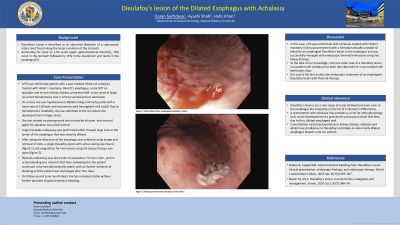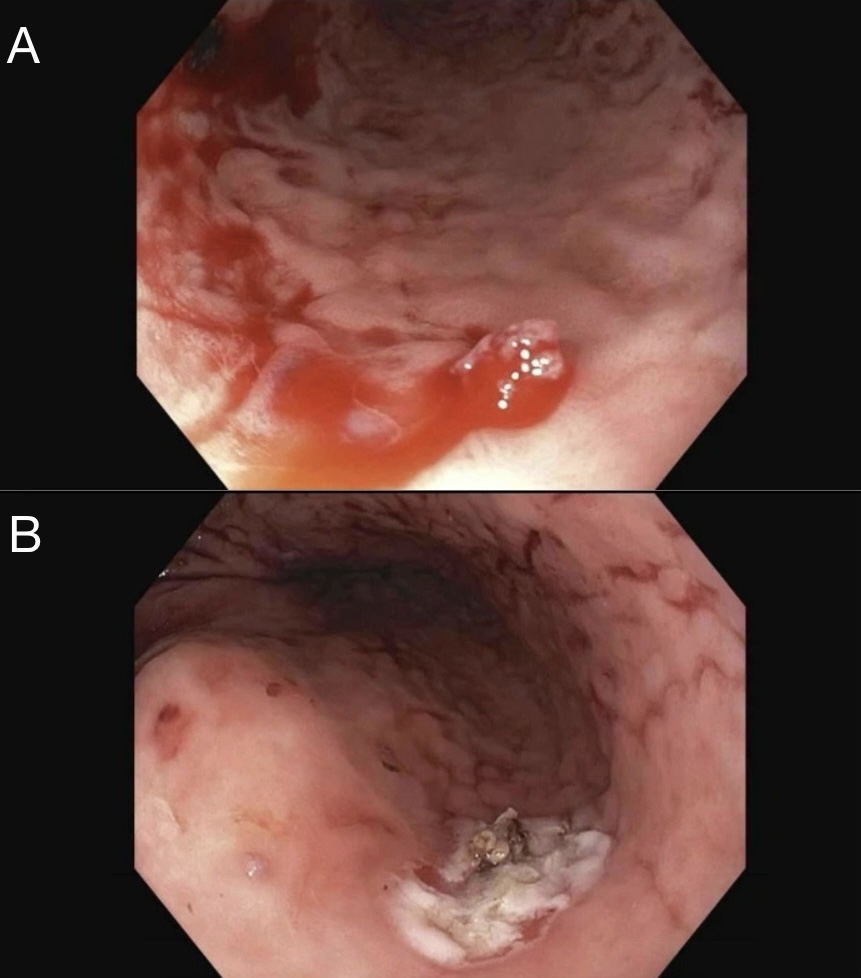Tuesday Poster Session
Category: Esophagus
P3994 - Dieulafoy’s Lesion of the Dilated Esophagus Due to Achalasia
Tuesday, October 29, 2024
10:30 AM - 4:00 PM ET
Location: Exhibit Hall E

Has Audio

Karan Sachdeva, MBBS, MPH
SUNY Upstate Medical University
Syracuse, NY
Presenting Author(s)
Karan Sachdeva, MBBS, MPH, Ayushi Shah, MBBS, Hafiz Muzaffar Akbar Khan, MD
SUNY Upstate Medical University, Syracuse, NY
Introduction: Dieulafoy’s lesion is an abnormal dilatation of a submucosal artery accounting for close to 1.5% acute upper gastrointestinal bleeds. Here, we describe a rare presentation of the Dieulafoy’s lesion in an abnormally dilated esophagus in a patient with known achalasia.
Case Description/Methods: A 93 year old female patient with a past medical history of achalasia treated with Heller’s myotomy, Barrett's esophagus, acute DVT on apixaban and chronic kidney disease, presented with acute onset of large, recurrent hematemesis over a 12 hour period prior to admission. On arrival, she was hypotensive (80/60 mmHg), tachycardic (120 bpm) and had anemia with hemoglobin of 8.4 g/dl. Due to hemodynamic instability, she was admitted to the ICU where she developed hemorrhagic shock. She was started on pantoprazole and octreotide infusion, and reversal agent for apixaban was administered. Urgent bedside endoscopy was performed which showed large clots in the lumen of the esophagus that was severely dilated. After adequate clearance of the esophagus was achieved using lavage and retrieval of clots, a single Dieulafoy lesion with active oozing was found (figure A) and coagulation for hemostasis using hot biopsy forceps was done (figure B). Recheck endoscopy prior to extubation 72 hours later showed no active bleeding and the patient continued to be hemodynamically stable. Apixaban was resumed after a risk benefit discussion and on follow up visit (one month later), she has remained stable without further episodes of gastrointestinal bleeding.
Discussion: To the best of our knowledge, our case is the first to describe endoscopic treatment of an esophageal Dieulafoy lesion with thermal therapy in Achalasia. The etiology of these lesions has been elusive but the presentation with achalasia may provide us a link for pathophysiology such as the development of a prominent submucosal vessel that bled due to thin, dilated esophageal wall and opens grounds for further studies. Other causes of gastrointestinal bleeding in patients with esophageal motility disorders include esophageal varices, diverticulum, carcinoma and post dilatation of sphincter. Comorbidities including hypertension, kidney disease, diabetes and alcohol use predispose to Dieulafoy’s and we suspect that these combined with an abnormally dilated esophagus contributed in our patient. This case highlights that such bleeding lesions may be encountered in patients with a dilated esophagus and should be kept on the differential.

Disclosures:
Karan Sachdeva, MBBS, MPH, Ayushi Shah, MBBS, Hafiz Muzaffar Akbar Khan, MD. P3994 - Dieulafoy’s Lesion of the Dilated Esophagus Due to Achalasia, ACG 2024 Annual Scientific Meeting Abstracts. Philadelphia, PA: American College of Gastroenterology.
SUNY Upstate Medical University, Syracuse, NY
Introduction: Dieulafoy’s lesion is an abnormal dilatation of a submucosal artery accounting for close to 1.5% acute upper gastrointestinal bleeds. Here, we describe a rare presentation of the Dieulafoy’s lesion in an abnormally dilated esophagus in a patient with known achalasia.
Case Description/Methods: A 93 year old female patient with a past medical history of achalasia treated with Heller’s myotomy, Barrett's esophagus, acute DVT on apixaban and chronic kidney disease, presented with acute onset of large, recurrent hematemesis over a 12 hour period prior to admission. On arrival, she was hypotensive (80/60 mmHg), tachycardic (120 bpm) and had anemia with hemoglobin of 8.4 g/dl. Due to hemodynamic instability, she was admitted to the ICU where she developed hemorrhagic shock. She was started on pantoprazole and octreotide infusion, and reversal agent for apixaban was administered. Urgent bedside endoscopy was performed which showed large clots in the lumen of the esophagus that was severely dilated. After adequate clearance of the esophagus was achieved using lavage and retrieval of clots, a single Dieulafoy lesion with active oozing was found (figure A) and coagulation for hemostasis using hot biopsy forceps was done (figure B). Recheck endoscopy prior to extubation 72 hours later showed no active bleeding and the patient continued to be hemodynamically stable. Apixaban was resumed after a risk benefit discussion and on follow up visit (one month later), she has remained stable without further episodes of gastrointestinal bleeding.
Discussion: To the best of our knowledge, our case is the first to describe endoscopic treatment of an esophageal Dieulafoy lesion with thermal therapy in Achalasia. The etiology of these lesions has been elusive but the presentation with achalasia may provide us a link for pathophysiology such as the development of a prominent submucosal vessel that bled due to thin, dilated esophageal wall and opens grounds for further studies. Other causes of gastrointestinal bleeding in patients with esophageal motility disorders include esophageal varices, diverticulum, carcinoma and post dilatation of sphincter. Comorbidities including hypertension, kidney disease, diabetes and alcohol use predispose to Dieulafoy’s and we suspect that these combined with an abnormally dilated esophagus contributed in our patient. This case highlights that such bleeding lesions may be encountered in patients with a dilated esophagus and should be kept on the differential.

Figure: A: Active bleed from esophageal Dieulafoy’s lesion; B: Endoscopic thermal hemostasis of the lesion
Disclosures:
Karan Sachdeva indicated no relevant financial relationships.
Ayushi Shah indicated no relevant financial relationships.
Hafiz Muzaffar Akbar Khan indicated no relevant financial relationships.
Karan Sachdeva, MBBS, MPH, Ayushi Shah, MBBS, Hafiz Muzaffar Akbar Khan, MD. P3994 - Dieulafoy’s Lesion of the Dilated Esophagus Due to Achalasia, ACG 2024 Annual Scientific Meeting Abstracts. Philadelphia, PA: American College of Gastroenterology.
